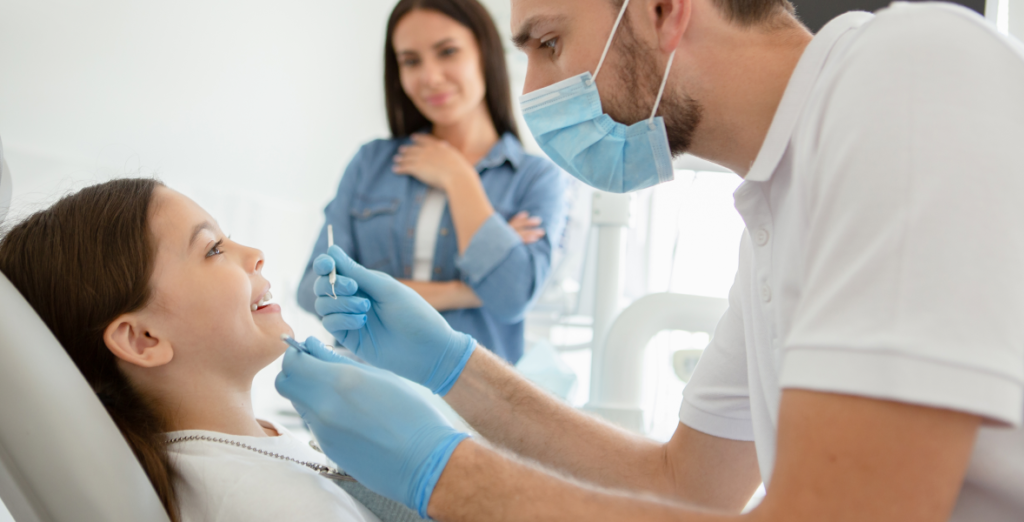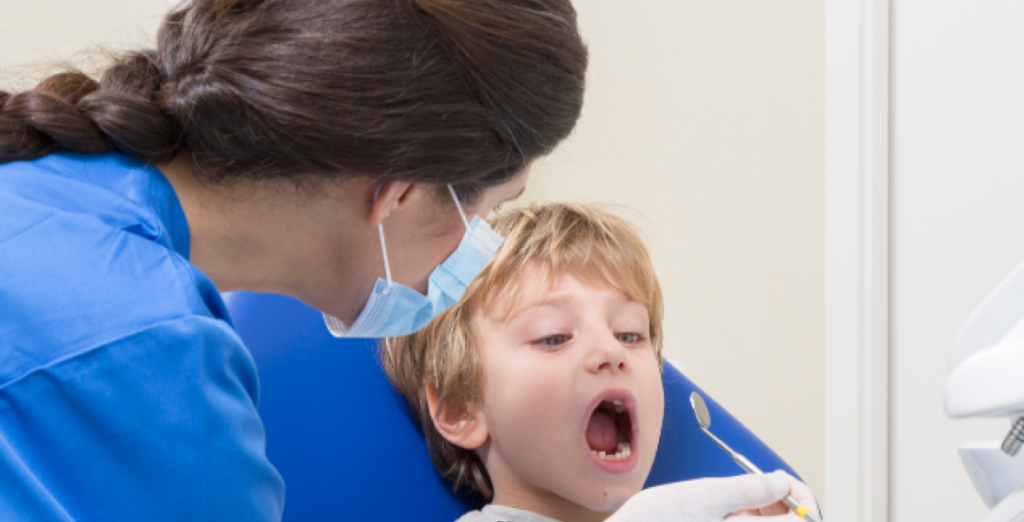This treatment is for you if…
Your child is under 16.
What is paediatric dentistry?
Paediatric dentistry is the branch of odontology dealing with the diagnosis and treatment of childhood dental illnesses from early infancy until the beginning of puberty.
The objective of paediatric dentistry treatments is to accompany the growth and development of correct teeth to detect and prevent serious oral problems in adulthood. At this age, it is highly important to incorporate good dental health and hygiene habits and to provide an immediate response to problems that may appear, in many cases, with respect to temporary or milk teeth.
Among the illnesses and problems that may appear in these stages that require immediate action are tooth decay and dental traumas.

What type of treatments are used in paediatric dentistry?
Paediatric dentistry treatments can vary based on whether they are performed on milk or definitive teeth. They also depend on the seriousness of the problem to be treated.
Some of the most common problems are as follows:
Pulpotomy and pulpectomy
These treatments are very similar to the root canal work carried out in adults. They are carried out to treat tooth decay that has affected the pulp or nerve of the milk teeth. The first step in this treatment is the pulpotomy, which extracts the pulp chamber from the tooth. When tooth decay is very advanced, a pulpectomy is performed, which consists of extracting the pulp completely, both that located in the chamber and in the root ducts to then seal them.

Fillings or seals
In the event of tooth decay, a filling is placed when it only affects the enamel or the dentine but not the pulp. A crown can also be placed if the tooth decay is very extensive to protect the tooth.
Application of fluoride
Paediatric dentistry has a large preventative component and the most used preventative treatment is the application of fluoride. Fluoride is used to help teeth to grow strong and healthy and to strengthen the enamel.
Interceptive orthodontics or orthopaedics
Used to correct and guide the growth of maxillary bones, since it is easiest to do so in early ages, and to avoid serious problems in the future.
Advantages of paediatric dentistry
The care of teeth during childhood and adolescence has numerous long- and short- term benefits.
- Improvement and correction of habits. Harmful problems such as thumb-sucking and pushing teeth can cause problems in the development of the maxillary teeth.
- Improved bite. Occlusion problems such as an open bite, crossbite or overbite can be corrected.
- Correction of growth. The growth of the jaw and the maxillary bone must be adequate to accommodate the emerging teeth.
- Prevention of future risks. Paediatric dentistry treatments have preventative functions to prevent the definitive teeth from emerging in harmful positions.
- Avoids pain. The main cause of pain at early ages is tooth decay. Curing or preventing such illness can prevent discomfort in small children.
- Happy healthy smile. Both during the growth stage and as adults, odontological treatments allow a healthy smile to be maintained and, in the long term, the aesthetic benefits can also have an impact on self-esteem.

Paediatric dentistry treatment phases
It is important to take into account that paediatric dentistry is, to a large extent, preventative. Hence, it is recommended that a child’s first visit to the dentist occurs when the child is one years old.
In that visit, the specialist will check the degree of growth of the maxillary and the jaw, and the emergence of the teeth, and they will rule out premature illnesses, such as tooth decay.
Parents are responsible for ensuring that their children acquire appropriate oral health. Accordingly, children’s dentists and hygienists will help to resolve their doubts regarding hygiene and brushing and regarding practices that can be harmful for correct oral health development.
Up to three years of age, visits are considered to be of a preventative nature and if there are no problems, only an annual visit will be required. However, from the age of five years old, it is recommendable to carry out a check-up every six months.

The treatment phases, if necessary, depend on the type of pathology presented by the child. These are the most common:
- Tooth decay. Tooth decay is the most frequent childhood illness, especially at pre-school age. Normally, it is caused by a high sugar consumption and inadequate dental hygiene. Among the most common symptoms are intense pain and infections.
Treating said tooth decay depends on whether it only affects the enamel or whether it has reached the dentine and the pulp. When it only affects the enamel, the child will have a filling, and when the tooth decay is deeper, a metallic crown will be placed to not prevent the remaining teeth from emerging.
When it also affects the pulp, a pulpotomy may be necessary to extract the affected pulp, attempting to preserve the pulp of the roots whenever possible. Pulling out a tooth is always the last option and only when the tooth can no longer fulfil its function. In milk teeth, moreover, a space maintainer is placed so that the definitive teeth emerge without problems if a long time still remains for them to emerge.
- Dental traumas. Blows and minor accidents are common in children and teenagers, leading to dental traumas such as cracks, splinters or breakages.
With small cracks, it is not normally necessary to take action beyond polishing the teeth. When the cracks are bigger, a filling material can be used. In the event of splintered or broken teeth, the solutions can be diverse, from the application of filling material to the removal of the tooth. In any case, it will always be the paediatric dentist that assesses the solution required.
- Divergence of teeth and maxillary teeth. Interceptive orthodontics corrects the position of teeth and maxillary teeth when it is easier to do so -at an early age- to avoid future problems.
This treatment has two phases:
1. The first phase begins with the milk teeth to obtain a correct bite, correct harmful oral habits, prevent the development of a problem and intervene in time. It also guides the growth of the jaw and maxillary bones that hold the teeth, so that they emerge correctly.
2. The second phase is carried out when the child is growing, to make the necessary dental corrections. Orthodontics will be performed to move the permanent teeth to their final positions, to improve their functionality and the child’s facial appearance during their adolescence.
Frequently asked questions
Odontopaediatrics focuses on the dental health of children, from infancy to adolescence. It includes the diagnosis, prevention, treatment and repair of dental problems in children. It is important to ensure that children’s teeth develop correctly and to include healthy habits from an early age.
It is recommended to make the first visit to the odontopaediatrician when the baby’s first tooth appears or, at the latest, when they turn one year old. This helps to detect possible early problems and get the child used to visiting the dentist.
An odontopaediatrician offers a wide range of treatments, including regular check-ups, scales and polishes, treatment of tooth decay, jaw orthopaedics, the handling of oral habits such as thumb-sucking and specialised attention for children with medical or special development needs.
Odontopaediatricians are trained to work with children and use friendly techniques and approaches to reduce anxiety. Such approaches and techniques may include explaining procedures in a language that the child can understand, using distractions, positive reinforcement and working with parents to prepare the child for the visit.
Parents can promote good dental hygiene habits, showing their children how to brush their teeth and use dental floss correctly, providing a balanced diet, limiting sugar and ensuring that they attend frequent dental check-ups. Working with an odontopaediatrician is essential to maintain optimum dental health for children.
Prices
The amounts indicated have been estimated in line with a full treatment, in accordance with the parameters in the table. Includes: study, treatment and check-ups during the treatment, so it serves as a guide and is of a merely informative non-contractual nature. The personalised treatment will be examined in line with the medical prescription. Prices can be increased if additional costs are incurred as a result of the requests made by each customer. Price valid until 31 December 2024 except in the event of a typing error.

